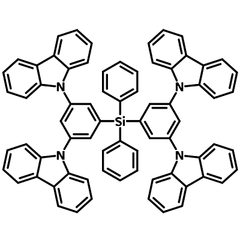SimCP2
CAS Number 944465-42-3
High Purity Sublimed Materials, Host Materials, Semiconducting Molecules, TADF Materials
SimCP2, ambipolar phosphorescent host materials
Enhance the lifetime and colour purity of OLED devices with high luminance
SimCP2, 3,5-di(9H-carbazol-9-yl)tetraphenylsilane, contains four electron-donating carbazole groups with two mCP units (a well known host material) joined together by a diphenylsilane link. The mCP joined structure makes SimCP2 more robust to support the growth of high quality thin films, and it is also believed that the rigid structure can enhance the lifetime and colour purity of OLED devices with high luminance.
SimCP2 also possesses a wide triplet band gap (ET = 3.0 eV), high carrier mobility, ambipolar transport property and high glass transition temperature (Tg = 148 °C).
The solution processability of SimCP2 also gives it an advantage in device fabrication, where it can be used to enable higher device efficiency with homogeneous distribution of the host and guest in the emissive layer.
General Information
| CAS number | 944465-42-3 |
|---|---|
| Chemical formula | C72H48N4Si |
| Molecular weight | 977.26 g/mol |
| Absorption* | λmax 338 nm (dichloromethane) |
| Photoluminescence | λem 362 nm (dichloromethane) |
| HOMO/LUMO | HOMO = 6.1 eV, LUMO = 2.5 eV; ET = 3.0 eV [1] |
| Chemical name | Bis[3,5-di(9H -carbazol-9-yl)phenyl]diphenylsilane |
| Synonyms | TPINQ |
| Classification / Family | Triphenylamine derivatives, Phosphorescent host materials, Sublimed materials, Semiconducting small molecules |
* Measurable with an optical spectrometer, see our spectrometer application notes.
Product Details
| Purity | Sublimed >99.0% (HPLC) |
|---|---|
| Melting point | Tg = 148 °C (lit.) |
| Appearance | White powder/crystals |
* Sublimation is a technique used to obtain ultra pure-grade chemicals, see sublimed materials.
Chemical Structure

Device Structure(s)
| Device structure | ITO/PEDOT:PSS (60 nm)/PVK+SimCP2 (70 wt.%)+OXD-7 (70 wt.%)+FIrpic(5 wt.%)(70 nm)/CsF/Al [2] |
|---|---|
| Colour |
|
| Max. Current Efficiency | 15.8 cd/A |
| Max. Power Efficiency | 11 Im/W |
| Device structure | ITO (125 nm)/PEDOT:PSS (35 nm)/SimCP2:FIrpic (35 nm)/TPBi (28 nm)/LiF (0.8 nm)/Al (150 nm) [1] |
|---|---|
| Colour |
|
| Max. EQE | 17.7% |
| Max. Power Efficiency | 24.2 Im/W |
Pricing
| Grade | Order Code | Quantity | Price |
|---|---|---|---|
| Sublimed (>99.0% purity) | M2291A1 | 100 mg | £220 |
| Sublimed (>99.0% purity) | M2291A1 | 250 mg | £440 |
| Sublimed (>99.0% purity) | M2291A1 | 500 mg | £740 |
| Sublimed (>99.0% purity) | M2291A1 | 1 g | £1200 |
MSDS Documentation
Literature and Reviews
- High-Efficiency Blue Organic Light-Emitting Diode Using a 3,5-di(9H-carbazol-9-yl)tetraphenylsilane Host via Solution-Process, J. Mater. Chem., 20, 8411-8416 (2010); DOI: 10.1039/C0JM01163K.
- Efficiency enhancement of solution-processed single-layer blue-phosphorescence organic light-emitting devices having co-host materials of polymer (PVK) and small-molecule (SimCP2), S-W. Liu et al., J. SID 19 (4), 346-352 (2011); DOI: 10.1889/JSID19.4.346.
- Inkjet printing of blue phosphorescent light-emitting layer based on bis(3,5-di(9H-carbazol-9-yl))diphenylsilane, R. Bail et al., RSC Adv., 8, 11191 (2018); DOI: 10.1039/C8RA00582F.

 SimCP2 MSDS sheet
SimCP2 MSDS sheet